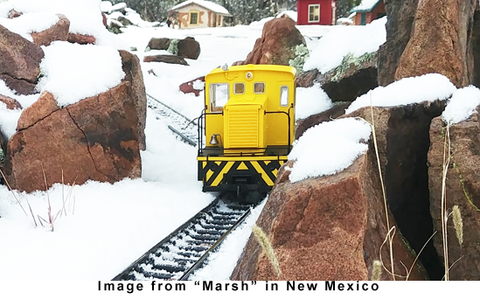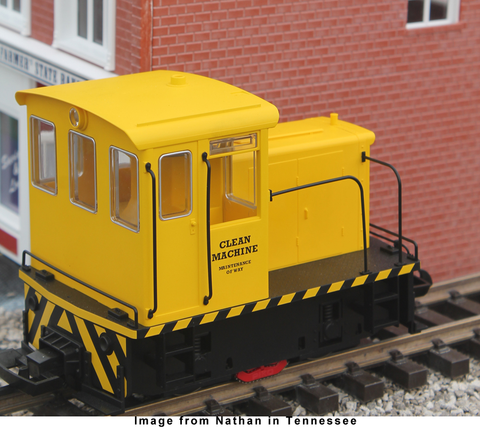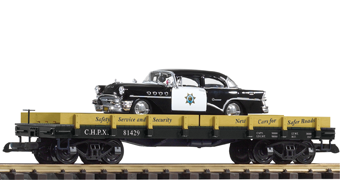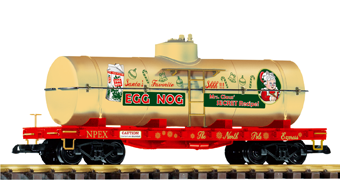Fall/Autumn 2022 New Item Announcements
We recently sent out an email announcing 16 new items for North America, in both G- and HO-Scales. We hope you get a chance to see all the new items coming from PIKO this year!
We recently sent out an email announcing 16 new items for North America, in both G- and HO-Scales. We hope you get a chance to see all the new items coming from PIKO this year!
Track Facts: A Series Explaining the Truth Others Don't Want You to Know.
In our last Track Facts, we discussed the error in the statement that “Brass is Brass.” It’s not all the same!
In our current episode of Track Facts, we will show you how important it is to have the correct “Recipe” and why recycled brass cannot match “Virgin Brass rail”.
Is Virgin Brass a Big Deal?
Is the term “Virgin Brass” just a clever marketing term? Absolutely NOT! It has real meaning. Virgin Brass means all the metals that go into making the brass alloy have been:
Notice one extremely critical thing that is not mentioned in this process – there is no recycled scrap metal anywhere! Recycling is good for the environment, but you don’t want recycled materials in your rails!
Obviously, brass made with recycled materials, also known as scrap metals, should cost less and be more readily available. Relatively small metal recycling and reprocessing plants can be found in many locations around the world. And these metals can be used for many things where the purity of the alloy is not so important. But remember what we said about alloys in earlier episodes of Track Facts – little changes in the “ingredients” make a big difference in the results. Rail made from scrap metal is not good for your railroad. And yes, certain brands have sold tons of it to G-scale customers.
What About Recycled Brass?
A big problem with recycled brass is the impossibility of removing every bit of impurities. For example, a seemingly little thing like 1% or so of scrap iron remaining in your brass may not sound like much. And it’s nearly impossible to find recycled brass with “only” 1% of scrap iron in it. Most recycled brass has between 5% and 10% of undesired substances in it, usually more than half of that being scrap iron. With that, you get a brass that is harder to work with, and far more importantly, a brass that actually develops surface rust. With only 1% percent or so of scrap aluminum remaining in the mix, you get brass that stays an ugly, unnatural, bright yellow color for years outdoors.
Ugly-looking rail is only the beginning... There are a dozen (usually more) other metals and substances, in varying percentages, which only make a poorer rail material and simply can’t be removed from the recycled brass alloy. Recycled brass is impure and can never go back to being virgin brass. These things make a huge difference!
With recycled “scrap” brass, you get a brass that does not conduct electricity as well, and a brass that oxidizes or corrodes much more rapidly. It’s much harder to clean and keep clean. In fact, the widespread proliferation of this rail material is one thing that led, decades ago, to some saying stainless steel was necessary for G-Scale rails. But solving one problem by creating other problems – as pointed out in Track Facts episode 1 – is not the way to do it.
Aside from this, you never really know from one batch of scrap brass rail to the next exactly what it will be. Not just the big ingredients like copper and zinc, but the percentages of all the substances in the rail will vary widely. Some may be better, some worse, but none of it is good for your G-Scale rails. Given how cheap and commonly available recycled scrap brass is around the world, you might wonder why track made with these rails would be more expensive than track made with the ideal virgin brass rail alloy. And when you hear someone saying no other track can match up to the quality of their low-grade brass track, you might wonder where the facts are to back up those claims.
More to come next time...
Track Facts: A Series Explaining the Truth Others Don't Want You to Know.
In our last Track Facts, we discussed how Brass is, all things considered, the best material for G-Scale track rails. (To see that article, click the link here.)
In this episode of Track Facts, we will explain some of the reasons we can say that all brass is NOT created equal.
There’s probably someone who is well-known among your family and friends for a certain recipe. And you may have tried other recipes that go by the same name, but they just aren’t the same. Some may come closer than others, and some you can barely even eat. It’s much the same with metals (not the eating part – don’t do that!😊).
Brass is an alloy, a mixture, made mostly of copper and zinc. A wide range of alloys can correctly be called “brass”, but changing the percentages of what’s in the alloy, even just a percent or two, can give vastly different results. Most of them are less than ideal for G-Scale train rail.
No model train brand actually mines the metal ore, refines it and processes it into the finished rail material. Every brand depends on a specialized metal supplier to provide the finished rail. But not every brand gives their metal supplier extremely tight specifications that make for an ideal brass rail alloy. For example, copper is expensive, so a supplier naturally wants to provide a lower-copper alloy. As the copper content drops down around 60% or lower, it’s still brass, but a much poorer conductor, less malleable, and with a lot of other problems that make it far worse for model train rails.
Most model train brands don’t even have the technical knowledge to know what they should demand. And not every brand inspects the rail and does metallurgical testing to ensure that their specifications are being followed. Whether from simple ignorance and not knowing how critical this is, or from a desire to cut costs, or various other reasons, some well-known brands have failed to ensure that their rail is an ideal and consistently high-quality material.
It’s also not easy to find a metal supplier who will meet the demanding standards needed for an ideal brass rail. This requires the resources of what is usually a massive multi-national industrial conglomerate, combined with a willingness to deal with the comparatively small tonnages of rail material needed for the G-Scale train business. There are only a handful of suppliers in the world who have the technical ability to do this. But if no one checks and really insists that every piece of rail meets the standards, then the supplier will absolutely deliver a cheaper, sub-standard rail material, as sure as the sun coming up in the morning. And the worldwide list of suppliers who will actually continue to meet the most exacting standards is truly short.
You may be starting to see how “Brass is Brass” thinking is completely wrong… Next time we discuss ‘Virgin Brass’ rail, and why it matters…
Track Facts: A Series Explaining the Truth Others Don't Want You to Know.
If you want to know track, first you want to start with the options for electrical conduction. Electrical conduction is basically the passage of electricity through a medium, or conductor. (Not a train conductor, a material. 😊)
There are a few well-known, and readily available, metals used for electrical conduction...
Silver – Silver is one of the most conductive metals on Earth. This is because silver only has one valence electron. This single electron is free to move around with little resistance. As a result, metals like silver and copper are a few of the metals with this particular characteristic which makes them great for electrical and thermal conduction. Of course, silver is too expensive for use in G-Scale track.
Copper – Copper, like silver, only has one valence electron which makes this metal very conductive. (This is why high-end cookware commonly has a coating of copper.) Copper is also a soft metal, which makes it nicely flexible for electrical wiring.
Gold – The combination of gold’s resistance to corrosion and its excellent conductivity make this metal an extremely valuable resource used in the electronics industry. But gold is obviously not a cost-effective solution for track.
Aluminum – Overall, aluminum is an excellent conductor for heat and electricity. The high heat conduction is especially noticeable over time, in that the metal gets hotter the longer current is active. Aluminum wiring caused electrical fires in many homes built in the 1960's, which is why it is no longer used. Aluminum is also not a highly durable metal for G-Scale rails. It is comparatively soft and pliable. Stepping or dropping something on aluminum rails could easily damage them and aluminum can be easily worn down by the harder metal wheels of the trains.
Finally, aluminum exposed to the elements starts forming aluminum oxide, called alumina, within minutes. Alumina, once coating the rails, results in a very poor electrical conductor. In fact, alumina is actually used as an electrical insulator, the exact opposite of what is wanted for track-powered trains.
Brass – Brass is an alloy. The specific brass alloy used for PIKO G-Track rails is a mixture mostly of copper and zinc, with a small percentage of lead. While brass is technically less conductive than these other four metals, its durability and resistance to the elements increase its value for G-Scale rails. This particular alloy is also known for its excellent machinability and malleability, such as fabricating the material into G-Scale rails.
The small percentage of lead is a necessary inert part of the alloy. Risk of exposure would mainly come from grinding up the rail and then handling or ingesting the dust, which is not something done in normal use. Many years ago, another brand was trying to sound concerned when they proudly proclaimed to all that they would seek to remove all lead from their rail. Of course, this produces a brittle, almost completely unworkable material that is virtually useless for rail.
Nickel-Silver – In the model train world, Nickel-Silver has become a common rail material for smaller scales. It actually contains no silver. The name comes from the silvery appearance when clean. Nickel-Silver rail is an alloy made primarily of copper, nickel and zinc, with a small percentage of lead. It has a relatively high electrical resistance, so it loses considerable voltage over distance, and it has decent corrosion resistance. In the volumes needed to make a piece of G-Scale track, the higher price versus brass rail would make a big difference in your budget.
Metal pricing fluctuates constantly, however we can give you a rough comparison of costs. PIKO uses a special grade of virgin brass that is one of the more expensive brass alloys. Still, it costs a fraction of some other conductors. As of this post:
Silver was over ten times the price of brass per pound.
Gold was over 400 times the price of brass per pound.
Aluminum was less than half the cost of brass per pound, which makes one wonder why the far less ideal aluminum rail costs as much as it does.
Nickel-Silver was more than double the price of brass per pound, enough to be quite unattractive in the sheer volumes of metal needed for big, durable, Code 332 G-Scale rail. Combined with the voltage loss over distance, this becomes a rather poor option for G-Scale.
All things considered, brass is by far the most ideal material for G-Scale rails. (That is, unless you want to pay for silver or gold rails!) We have noted that aluminum is not a durable metal - it conducts heat, is easily damaged and wears quickly. Stainless steel - another metal that has been promoted for G-Scale track - is a 40-50% less efficient conductor than brass, is more expensive, is hard to work with, rapidly wears wheels, and expands and contracts far more with temperature changes. Nickel-Silver is more expensive and has voltage loss over distance. So, brass rail is the clear winner due to durability/longevity, conductivity, ease of use, ease of maintenance and price!
But all brass is not created equal! More about that next time...
We woke up this morning and saw a review of the PIKO #52466 USATC Whitcomb 65T Diesel Loco posted online by a well-known model train reviewer, James Wright. We figure the review will give you a good idea of this new model from PIKO.
Official North American versions will be in production soon and there are sure to be more announcements coming regarding this historied model.
When going through our images, we came upon this find... a rare image from Spring 1945 - in a small German town safely in Allied hands, a USATC crew is busy switching some cars at the station.
Actually, these images are a sneak peak of our new 52466 #USATC #Whitcomb 65-Ton #Diesel #Loco w/Sound. We just couldn't wait to show you. We hope you enjoy the images!




With the arrival of our GE 25-Ton Diesel Switchers, finalizing 2019 products, and the busy 2018 holiday season we missed updating the News section of the website. We hope you can forgive us.
 As we prepare this news blog, more reviews of our new GE 25-Ton loco variations are being published and we thought you might want to see some of them. For good reason, folks seem to be quite impressed with the accuracy of the little beasts. With most of these pint-sized models weighing in at just about 3 pounds, people are finding they pull a good number of cars as well. Considering the real-life locos usually maxed out pulling 3-4 cars, we feel we were able to one-up the real thing!
As we prepare this news blog, more reviews of our new GE 25-Ton loco variations are being published and we thought you might want to see some of them. For good reason, folks seem to be quite impressed with the accuracy of the little beasts. With most of these pint-sized models weighing in at just about 3 pounds, people are finding they pull a good number of cars as well. Considering the real-life locos usually maxed out pulling 3-4 cars, we feel we were able to one-up the real thing!
 Of course, we are not done making these diminutive models. Our 2019 New Items Flyer and Catalog show more new items coming later this year, including four more GE 25-Ton locos and two starter sets. Some of them even include a new remote for radio control, continuing the PIKO tradition for innovation. Among the many reviews are this latest review from Garden Railways magazine which was published in the Spring issue for 2019. They also created a nice little video introducing folks to the model, with the link here.
Of course, we are not done making these diminutive models. Our 2019 New Items Flyer and Catalog show more new items coming later this year, including four more GE 25-Ton locos and two starter sets. Some of them even include a new remote for radio control, continuing the PIKO tradition for innovation. Among the many reviews are this latest review from Garden Railways magazine which was published in the Spring issue for 2019. They also created a nice little video introducing folks to the model, with the link here.
Model Railroad News, published by White River Productions, has also done thorough reviews of the 38150 Might Hauler Starter Set as well as on the complete line of 2018 models. (If you have not read MRN reviews, you are in for a treat as they always include a good amount of information on the prototype.)
We have even found YouTube channels with early reviews of this unique little loco. We hope you like watching these as much as we liked making the models!
For our model specific information booklet, you can follow the below link to an older news blog. https://www.piko-america.com/blogs/news/ge-25-ton-diesel-loco-new-model-info-booklet
As always, we hope you enjoy your PIKO trains!
New items from PIKO...

PIKO #38762: Christmas Tree Express
This car is a Low-Side Gondola with a load of snow-dusted trees coming straight from Santa’s Tree Farm. Plenty of details inside and out.
Produced only once!

PIKO #37813: Hermann Christmas Bear Car
PIKO exclusive, authentic mohair teddy bear with genuine excelsior stuffing, lovingly hand-made by the famous Hermann company in Coburg, Germany.
Produced only once!

PIKO #38761: Christmas Good List Auto Transport
Are you on Santa's Good List? This car carries a very special delivery… a diecast classic Corvette! Goes great by itself or added to our other North Pole Express offerings.
Produced only once!

PIKO #38246: Christmas Camelback
With directional LED lights, smoke & fantastic digital sound on Analog DC or Digital DCC. These were made only once, but we just couldn't get enough of them here last season. Don't miss out this year... when they're gone, they're gone!
New items from PIKO...

PIKO #38122: Christmas Freight Starter Set
This is our largest starter set so far! Aside from jaw-dropping graphics, the loco has working analog sound and smoke. The new set comes with two painstakingly decorated ore cars and a work caboose with festive packages. (with power supply and the BEST track on the market.)

PIKO #38760: CHP Cruiser Auto Transport
The CHP Cruiser Auto Transport carries a beautiful DieCast model of a 1955 Buick Century with all kinds of great features. The flatcar also has great molded in wood-grain details that you will love. Only Produced Once!

PIKO #38759: Christmas EggNog Tank Car
What says Christmas like holiday parties and EggNog? This tank car is sure to delight with Mrs. Claus' secret recipe.

PIKO #38884: Christmas Boxcar 2018
Our 8th annual car! Previous cars have always sold out. Nobody else has graphics like this! Only produced once!

PIKO #3883: Halloween Hopper
People are already talking about this one... We worked hard to make sure this hopper has glow-in-the-dark decorations! Great for a holiday train, or holding candy.